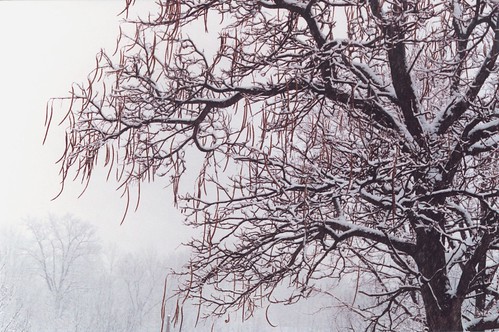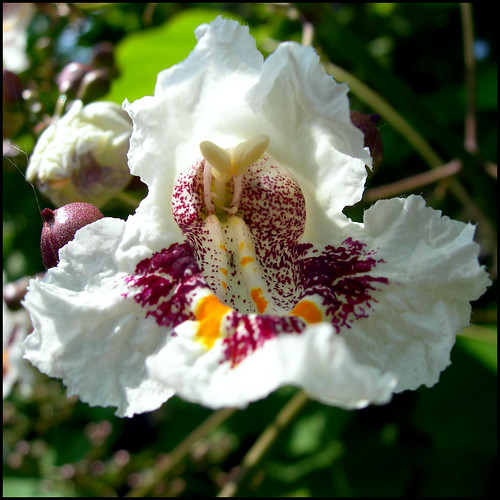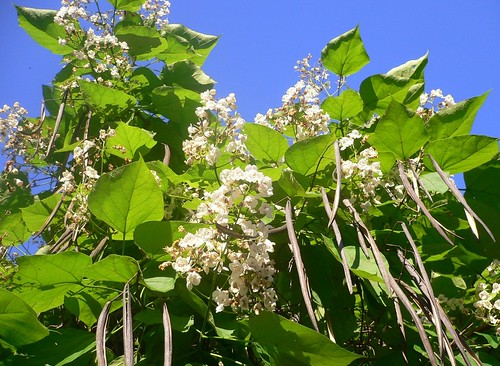
One of my favorite trees is in bloom right now. It is a tree I grew up with and played with the flowers that fell to the ground. It is the Catalpa speciosa or catawba tree.

TheGardenLady has one shedding its flowers on the side of her property. One delighted me by self seeding near the driveway. And I just transplanted a baby that self seeded or a bird planted in my perennial bed. I worry that the baby might not be happy in its new location because this is an area that might not have good drainage, which the catalpa likes. The catalpa tree does not like poor drainage or really feezing weather.
The catalpa tree has numerous common names like umbrella tree, Indian bean tree, Johnny smoker tree, Indian cigar tree, fish bait tree and Lincoln Log Tree. This is a tree that native Americans used and the early pioneers liked, seeing how successfully the tree lived under all sorts of situations from polluted cities to windswept prairies; how it grew quickly; lived long- up to 70 years; and had profuse fragrant flowers while it gave shade with its large heart shaped leaves. Farmers found they could use the wood, which makes strong, lightweight rot-resistant fence posts . In fact the northern catalpa is used for carving, millwork, framing, furniture, drawer sides, and general-purpose construction. The species is also intentionally planted to control erosion, aid brownfield revitalization or new stand growth, and as windbreaks and screening from the sun. Thus pioneers found a good tree to take with them wherever they moved. They planted catalpa trees on their new property all over the country.
There are two types of Catalpa trees: the larger more showy Northern C. speciosa and the Southern C. Bignoniaceae, but both seem to do well outside their range from zone 4 to 8. The nectar in their flowers entices hummingbirds, tiger swallowtail butterfly larva, and bees. The trees and seedpods attract lots of birds.
Though TheGardenLady has never had any problems with the catalpa trees on her property, they can have problems. One is the Catalpa Sphinx moth (or catawba sphinx moth) The caterpillars can cause defoliation; but if the tree is hardy it will have its leaves grow back unless major defoliation occurs for a few years in a row. Then the tree might see a limb die. Cut off any dead branches. A lot of fishermen find the caterpillar of the sphinx moth great for fishing. There is also a fungal disease that may affect the tree, but that is not too common. If a tree dies, do not plant another catalpa in the same area.
Warning : The flower pollen is quite allergenic so if there are allergies in the family, don’t plant the Catalpa. Also, the tree can become a large tree that will crowd other trees out or give heavy shade where plants can’t grow; so this is a tree for a fairly large yard. Know that the tree the roots are poisonous, Be wary that the sawdust from working with Catalpa wood can cause inhalant and skin allergy symptoms. Don’t use catalpa wood chips or shavings as animal bedding in case they might cause a problem for pets. The seedpods and seeds of catalpa contain a mild narcotic and sedative and should not be put in the mouth or eaten.


Bonjour, j’ai un Catalpa umbrella et je me demandait si on peux partir d’autres arbres avec les petites branches qui poussent au bas du tron d’arbre.
Merci à l’avance pour votre réponse.
Bonjour Louanne,
Je ne comprends pas votre question. Pourriez-vous s’il vous plaît demander d’une manière différente.
Merci
The Garden Lady
I pulled a branch off of a particular tree with giant leaves some 15 years ago and stuck it in the soil after being told that this was all it took to grow this type of tree.Today there is a tree growing there that is about 20 feet tall.When I was a kid in philadelphia we called these johnny smoker trees and my father often had us smoking them as a part of a camping frivolity.I now live in spring mount pa.which is about 20 miles from philly.Beautiful tree to look at.
I planted one of these trees 15 years ago by sticking a branch in the ground.Today it is 20 feet tall. MY father called this a johnny smoker tree when I was a kid.
Growing up in Southern New Jersey we only knew this tree as the “Johnny Smoker Tree”. As kids we would wait for the long “string bean like” pieces to fall off, dry them out in the sun, and try to smoke them like cigarettes. Terrible taste and probably turned many of us against smoking. Told the story to people many times, but never actually knew what it was called until I Goggled Johnny Smoker Tree today. It’s good to know it is a Catalpa tree.
I too grew up in Philadelphia and we called him Johnny smokers and we used to smoke them as kids
Where can I get some of these trees for my yard..I am hoping to find some because it reminds me of my youth my neighbors had one and I was always picking them for my mom..there was also a tulip tree very lovely trees..they draw hummingbirds thats why I loved them..also red trumpet vines and wisteria vines..I want to make my yard a butterfly and hummingbirds sanctuary..
I’m from Philadelphia also we had some parks in Philadelphia that would rather large right around mascher and Dauphin Street there were many Johnny smoke a trees that as kids we used to dry out the pods but you can never get them to smoke I now have them on my property in South Jersey and I must say they become a nuisance you can cut them to the ground and look wrote entries and its place I admit the flowers and very beautiful but the tree can block out sunlight from other plants anyone wants them I’ll send you a couple branches
I’d be interested in a few branches!